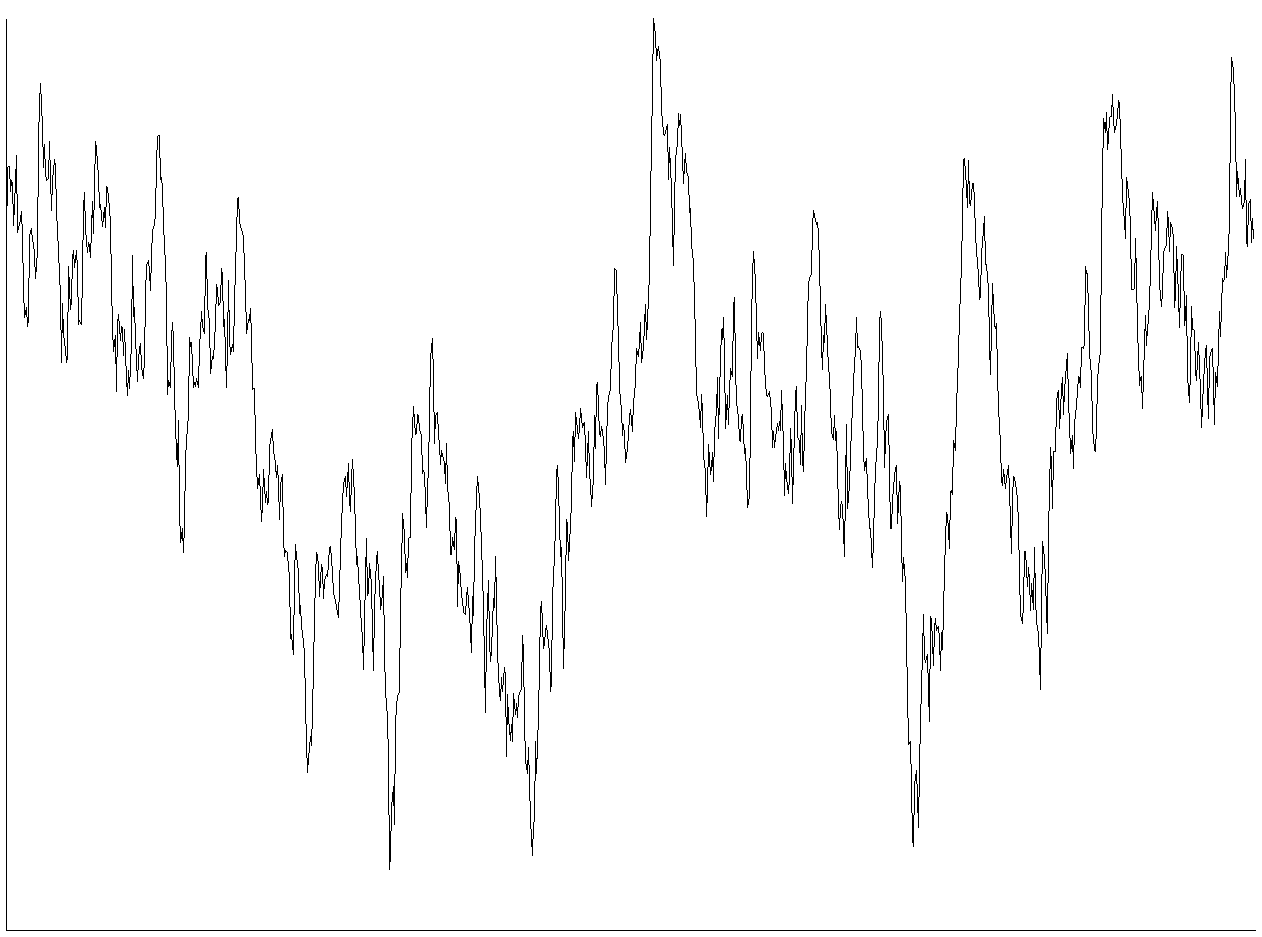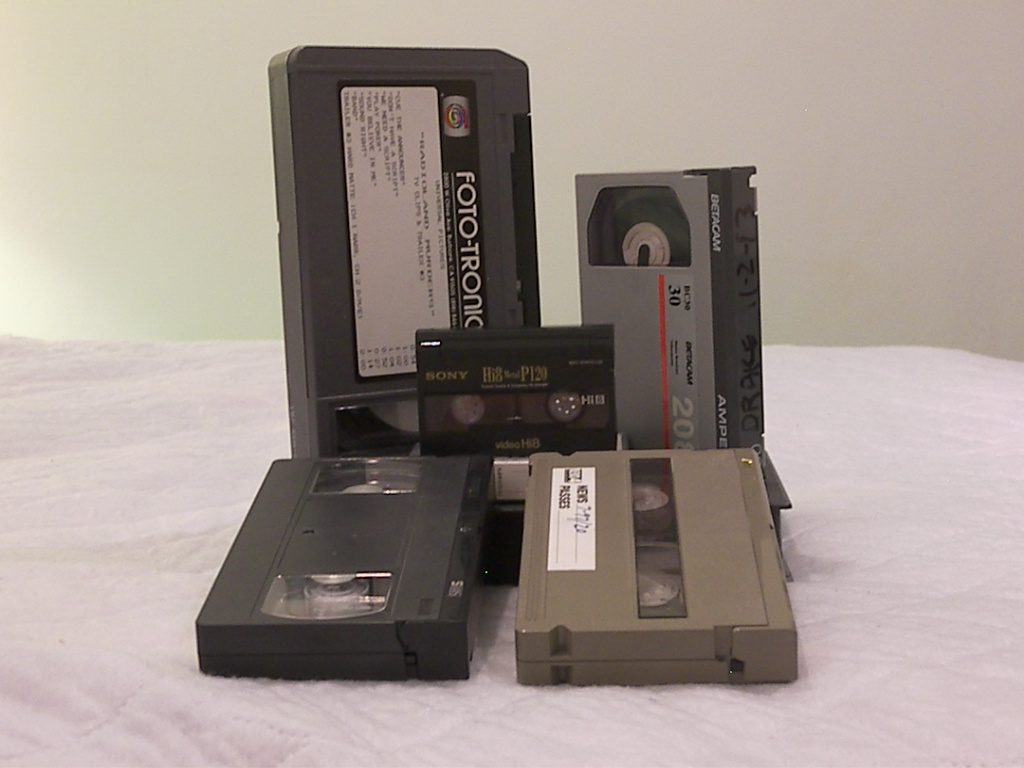|
Azimuth Recording
Azimuth recording is the use of a variation in angle between two recording heads that are recording data so close together on magnetic tape that crosstalk would otherwise likely occur. Normally, the head is perpendicular to the movement of the tape, and this is considered zero degrees. However, if the heads are mounted at slightly different angles (such as ±7 degrees in VHS), destructive interference will occur at high frequencies when reading data recorded in the cross-talking channel but not in the channel that is intended to be read. At low frequencies relative to the maximum allowed by the head gap, however, this technique is ineffective. Thus one head is slanted slightly leftwards and the magnetic gap of the other head slanted slightly rightwards. To look at it another way, channel A sees the channel B data stretched out in time, hence the technique has a low-pass effect on noise intruding from another channel. Every videotape system was designed to put as much video as ... [...More Info...] [...Related Items...] OR: [Wikipedia] [Google] [Baidu] |
Symmetric Phase Recording
Symmetric Phase Recording is a tape recording ( computer storage media) technology developed by Quantum Corporation packs data across a tape's recording surface by writing adjacent tracks in a herringbone pattern: track 0 = \\\\\, track 1 = /////, track 2 = \\\\\, track 3 = /////, etc. This eliminates crosstrack interference and guard bands so that more tracks of data can be stored on a tape. See also * Azimuth recording, Slant Azimuth recording *Digital Equipment Corporation *Digital Linear Tape *Linear Tape-Open * Digital Tape Format *Helical scan *Magnetic tape *Magnetic tape data storage *Storage Technology Corporation Storage Technology Corporation (StorageTek or STK, earlier STC) was a data storage technology company headquartered in Louisville, Colorado. New products include data retention systems, which it calls "information lifecycle management" (ILM). It ... References Further reading * * Storage media {{Compu-hardware-stub ... [...More Info...] [...Related Items...] OR: [Wikipedia] [Google] [Baidu] |
Magnetic Tape
Magnetic tape is a medium for magnetic storage made of a thin, magnetizable coating on a long, narrow strip of plastic film. It was developed in Germany in 1928, based on the earlier magnetic wire recording from Denmark. Devices that use magnetic tape can with relative ease record and play back audio, visual, and binary computer data. Magnetic tape revolutionized sound recording and reproduction and broadcasting. It allowed radio, which had always been broadcast live, to be recorded for later or repeated airing. Since the early 1950s, magnetic tape has been used with computers to store large quantities of data and is still used for backup purposes. Magnetic tape begins to degrade after 10–20 years and therefore is not an ideal medium for long-term archival storage. The exception is data tape formats like Linear Tape-Open, LTO which are specifically designed for long-term archiving. Information in magnetic tapes is often recorded in tracks which are narrow and long areas of in ... [...More Info...] [...Related Items...] OR: [Wikipedia] [Google] [Baidu] |
Destructive Interference
In physics, interference is a phenomenon in which two coherent waves are combined by adding their intensities or displacements with due consideration for their phase difference. The resultant wave may have greater amplitude (constructive interference) or lower amplitude (destructive interference) if the two waves are in phase or out of phase, respectively. Interference effects can be observed with all types of waves, for example, light, radio, acoustic, surface water waves, gravity waves, or matter waves as well as in loudspeakers as electrical waves. Etymology The word ''interference'' is derived from the Latin words ''inter'' which means "between" and ''fere'' which means "hit or strike", and was used in the context of wave superposition by Thomas Young in 1801. Mechanisms The principle of superposition of waves states that when two or more propagating waves of the same type are incident on the same point, the resultant amplitude at that point is equal to the ... [...More Info...] [...Related Items...] OR: [Wikipedia] [Google] [Baidu] |
Low-pass
A low-pass filter is a filter that passes signals with a frequency lower than a selected cutoff frequency and attenuates signals with frequencies higher than the cutoff frequency. The exact frequency response of the filter depends on the filter design. The filter is sometimes called a high-cut filter, or treble-cut filter in audio applications. A low-pass filter is the complement of a high-pass filter. In optics, high-pass and low-pass may have different meanings, depending on whether referring to the frequency or wavelength of light, since these variables are inversely related. High-pass frequency filters would act as low-pass wavelength filters, and vice versa. For this reason, it is a good practice to refer to wavelength filters as ''short-pass'' and ''long-pass'' to avoid confusion, which would correspond to ''high-pass'' and ''low-pass'' frequencies. Low-pass filters exist in many different forms, including electronic circuits such as a '' hiss filter'' used in audio, ... [...More Info...] [...Related Items...] OR: [Wikipedia] [Google] [Baidu] |
Noise (electronics)
In electronics, noise is an unwanted disturbance in an electrical signal. Noise generated by electronic devices varies greatly as it is produced by several different effects. In particular, noise is inherent in physics and central to thermodynamics. Any conductor with electrical resistance will generate thermal noise inherently. The final elimination of thermal noise in electronics can only be achieved cryogenically, and even then quantum noise would remain inherent. Electronic noise is a common component of noise in signal processing. In communication systems, noise is an error or undesired random disturbance of a useful information signal in a communication channel. The noise is a summation of unwanted or disturbing energy from natural and sometimes man-made sources. Noise is, however, typically distinguished from interference, for example in the signal-to-noise ratio (SNR), signal-to-interference ratio (SIR) and signal-to-noise plus interference ratio (SNIR) measu ... [...More Info...] [...Related Items...] OR: [Wikipedia] [Google] [Baidu] |
U-matic
U-matic, also known as -inch Type E Helical Scan or SMPTE E, is an analog recording videocassette format developed by Sony. First shown as a prototype in October 1969 and introduced commercially in September 1971, it was among the earliest video formats to house videotape inside a cassette, replacing the reel-to-reel systems common at the time. The format uses tape, earning it the nickname "three-quarter-inch" or simply "three-quarter," in contrast to larger open-reel formats like Type C videotape and quadruplex videotape. The name ''U-matic'' refers to the U-shaped tape path as it threads around the video drum. Unlike most cassette formats, U-matic's supply and take-up reels rotate in opposite directions during playback, fast-forward, and rewind—one clockwise, the other counterclockwise. Each cassette has an internal locking mechanism that secures the tape hubs during transport, and a spring-loaded door that protects the tape; this door automatically opens when the casse ... [...More Info...] [...Related Items...] OR: [Wikipedia] [Google] [Baidu] |
Betamax
Betamax (also known as Beta, and stylized as the Greek letter Beta, β in its logo) is a discontinued consumer analog Videotape, video cassette recording format developed by Sony. It was one of the main competitors in the videotape format war against its primary rival, VHS. Betamax was introduced in Japan on May 10, 1975, and launched in the United States later that year. Betamax was widely regarded, in part due to Sony's marketing, as offering superior picture quality compared to VHS. Its initial β1 speed provided 250 horizontal lines of resolution, compared to VHS's 240 lines, but early Beta tapes were limited to 60 minutes of recording time, making them impractical for recording movies or sporting events. To address this, Sony introduced the β2 speed, which doubled recording time to two hours but reduced resolution, negating its technical advantage. VHS's commercial success over Betamax was also driven by JVC's strategy of licensing the format broadly, spurring competition ... [...More Info...] [...Related Items...] OR: [Wikipedia] [Google] [Baidu] |
Tape Head
''Tape Head'' is the seventh studio album by American rock band King's X, released in 1998 via Metal Blade Records. A music video was made for the song "Fade". "World" is a reworked song from the band's ''Sneak Preview'' demos. The controversial unreleased track "Quality Control" is included on the album, but has been re-titled to "Happy". The majority of the lyrics are now different, including the lack of profanity. The album cover picture is that of Doug Pinnick wrapped in recording tape. According to Pinnick, he brought the songs "Happy", "Cupid" and "Hate You", and Ty Tabor brought "Ocean" to the ''Tape Head'' recording sessions. All other songs were band created during the recording session. The song "Walter Bela Farkas" was recorded live August 8, 1996, at the Tramps nightclub in New York City. Track listing All songs written by King's X. Personnel * Doug Pinnick – bass, vocals * Ty Tabor – guitar, vocals * Jerry Gaskill – drums, vocals Additional ... [...More Info...] [...Related Items...] OR: [Wikipedia] [Google] [Baidu] |
Helical Scan
Helical scan is a method of recording high-frequency signals on magnetic tape, used in open-reel video tape recorders, video cassette recorders, digital audio tape recorders, and some computer tape drives. With this technique, magnetic tape heads (or head chips) are placed on a rotating head drum, which moves the chips at high speed by due to its high angular velocity. The speed of the head chips must be higher than the linear speed of the tape. The tape is wrapped tightly around the drum. The drum and/or the tape is tilted at an angle that allows the head chips to read the tape diagonally. The linear speed of the tape is slower than the speed of the head chips, allowing high frequency signals to be read or recorded, such as video. As the tape moves linearly or length-wise, the head chips move across the width of the tape in a diagonal path. Due to geometry, this allows for high head chip speeds, known as writing speeds, to be achieved in spite of the low linear speed of the tap ... [...More Info...] [...Related Items...] OR: [Wikipedia] [Google] [Baidu] |



